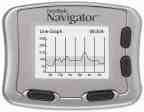Abbott Diabetes Care is already looking beyond continuous sensing. More than two years ago it asked the Food and Drug Administration to approve its FreeStyle Navigator Continuous Glucose Monitor, and that application is still pending.

The Navigator graphs BG levels
Right now, except for the GlucoWatch, there is only one continuous monitor on the market, but it is expensive and isn’t widely available. Medtronic Diabetes offers its Guardian RT, which I wrote about here in April 2005, in just seven cities as it works out insurance reimbursement.
Later this year Abbott expects to start selling its FreeStyle Navigator, which I first wrote about here in February 2005. Like the Guardian RT, it promises greater blood glucose control, peace of mind, and absence of fingersticks.
But that’s just the start. When you pair a continuous sensor with an insulin pump, you are reaching for one of the oldest dreams in diabetes management — the artificial pancreas.
In December the FDA approved Abbott’s insulin pump. Earlier, the company bought the technology from DEKA Research & Development, a private company that Dean Kamen founded. A prolific inventor with about 200 patents, Kamen is most famous for his Segway Human Transporter.
The Aviator is what Abbott calls its new insulin pump. Holly Kulp told me that it has some unique features. She is divisional vice president, in vivo worldwide marketing for Abbott Diabetes Care. “It is designed to be easy to use, easy to wear, and easy to learn.” And already the company is thinking about how the Aviator — or perhaps some other pump — will mate with the Navigator.
“We are committed to merging the Navigator and insulin delivery,” she says. “But we have not made any decisions, and are still evaluating commercialization options for the Aviator.”
She told me that they just have prototypes of the Aviator. If and when Abbott starts to produce Aviators, the first step in combining it with the Navigator will be what Ms. Kulp calls an open-loop diabetes management system. A system like this makes suggestions on the basis of actual glucose readings and trends for insulin delivery.
“The Holy Grail is truly a closed loop,” she adds. “But because of a lot of issues around physiology and the complications of being able to predict when somebody is going to exercise or eat, the open loop is the first step.”
It may be just a first step for Abbott. But when continuous sensors begin to be connected to insulin pumps, it will be a giant leap for people with diabetes.
Sidebar: The Competition
Abbott is a pharmaceutical giant with worldwide sales of $22 billion last year. It has the marketing clout and technology to challenge pump pioneer Medtronic Diabetes.
But Medtronic has a huge head start with its years of insulin pump experience, its 70 percent share of the pump market, and its approved continuous sensor. Medtronic’s forthcoming Paradigm 522/722 sensor-augmented insulin pump system will include Guardian RT technology.
The key point is that Abbott and Medtronic will both provide insulin pumps connected to continuous sensors. Whether Abbott or Medtronic is first to market, the real winners will be people with diabetes.
This article originally appeared in Diabetes Health, April 2006, p. 54..
![[Go Back]](back-new.gif) Go back to David Mendosa’s Home Page
Go back to David Mendosa’s Home Page
![[Go Back]](back-new.gif) Go back to David Mendosa’s Diabetes Directory
Go back to David Mendosa’s Diabetes Directory



